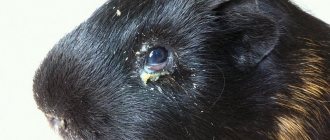- home
- Guinea pig
- Guinea pig health
02/14/2019 When purchasing a pet, you must make sure that it is in absolutely healthy condition. You need to find out everything from the seller, and also examine the pet yourself. Suitable and proper care is important for any animal; if it is not provided, the guinea pig may become ill or become infected with parasites. Ticks can cause serious harm. They are found in the fur, on or under the skin.
When and how does it become clear that a guinea pig has become infected?
Guinea pig mites are microscopic parasites that burrow under the skin. An animal can become infected from another animal by coming into contact with it even once for just a few minutes. The problem is that it is impossible to detect parasites immediately. The disease may not manifest itself for a long time - a surge in tick activity occurs when the animal is weakened. This may happen:
- when immunity is reduced due to any disease,
- with vitamin deficiency,
- in poor conditions of detention,
- in pregnant females,
- in young and elderly individuals.
An accurate diagnosis can only be made in the laboratory conditions of a veterinary clinic. To do this, scraping is done. In some cases, the analysis may turn out to be false - the indicators will be negative, but in fact the animal has a subcutaneous mite. Practice shows that larvae can be visualized only in 50% of cases.
A tick can be confused with an allergy – the symptoms are similar, but the parasite also causes painful symptoms. Signs that your guinea pig has subcutaneous mites:
- feeling of severe itching;
- soreness of the skin;
- the appearance of scratches on the body that swell and fester.
Diagnostics
If you think your pet has become infected with mites, consult your veterinarian. He will make an accurate diagnosis using:
- Detailed examination of the animal,
- Questioning the owner about the habits and condition of the pet,
- Scraping for subcutaneous mites.
After the diagnosis is made, diagnostic treatment is prescribed, which is carried out strictly under the supervision of a doctor.
Important! If diagnostic therapy does not help, a full course of treatment is prescribed.
Sarcoptic mange
This type of disease is caused by microscopic parasites of the Sarcoptidae family (scabies mites). They gnaw passages in the subcutaneous layer. A guinea pig becomes infected from contact with sick animals, through hay or other cage filler.
Visually, the disease manifests itself as characteristic triangular growths on the skin covered with a gray crust. In addition, the animal itches and hair falls out on its face and paws.
The disease is initially diagnosed by a bald face and paws covered with wounds. A skin scraping is taken for laboratory testing.
If sarcoptic mange is confirmed, then treatment of mites in guinea pigs involves treating the skin with acaricidal sprays. The active ingredient in their composition is selamectin, which destroys mature parasites and their eggs, which prevents further reproduction of the tick.
- During treatment, it is better to place the animal in a new small cage.
- His main home should be thoroughly disinfected.
- Throw away the old bedding and replace it with a new one only after the bottom of the cage has completely dried.
It is allowed to return the pig to its “house” a few hours after disinfection treatment.
Fungal, viral and oncological diseases
“Pigs” also suffer from fungal, viral and oncological diseases. All of them can be the root cause of pathologies of the kidneys, liver, heart and other systems mentioned above.
Tumors
In most cases, tumors develop in older pets. Their diversity is extremely large, but all neoplasms can be divided into two large types: benign and malignant. The following benign neoplasms are encountered in veterinary practice:
- Lipomas (from adipose tissue).
- Myomas (from muscle tissue).
- Adenomas (develop in the glands).
- In addition, fibroids are quite common in pigs (they grow from connective tissue).
As a rule, benign tumors do not manifest themselves in any way throughout the life of the mumps. The types of malignant tumors are no less diverse, but they are much more dangerous for the health and life of the pet:
- Carcinomas. Develop from epithelial tissue.
- Melanomas. Any mole on a pig’s body can “mutate” into something extremely dangerous.
- Sarcomas. They grow from connective tissue.
Other types of tumors in pigs are not very common. The clinical picture is as follows:
- As a rule, the animal becomes lethargic and quickly weakens.
- At first, appetite increases sharply, but as the disease progresses, it steadily worsens.
- Other symptoms directly depend on which organ the tumor has grown in. In particular, with liver damage the symptoms are the same, with kidney pathology the symptoms are different.
Fungal diseases
Fungal diseases are deservedly considered one of the most serious. They are very difficult to diagnose, but even more difficult to treat. The following ailments are detected in pigs:
- Ringworm (i.e. microsporia and trichophytosis).
- Weeping eczema (aka weeping lichen).
- Cheilitis mentioned above.
- Pityriasis versicolor.
- Deprive Zhiber.
- Lichen planus.
The variety of fungal pathologies is quite large. The following symptoms may indicate their development:
- Strange sores suddenly appear on your pet's skin. With many types of lichen, they have rounded outlines.
- Hair loss is very common. In many cases, the hairs do not fall out, but break off near the very root, which is why bristly areas dotted with “stumps” from broken hairs remain on the animal’s skin.
- The skin in these areas may become red, inflamed, scaly, and flaky.
- In many cases, the animal experiences severe and never-ending itching. The animal is worried, runs around the cage, rubs against all nearby surfaces.
- Many types of lichens are characterized by the development of pyoderma. In these cases, the skin is dotted with many pustules.
- If the case is advanced, the pig weakens, refuses food, and due to the “shrunken” immunity, the development of other infections is possible. First of all, the respiratory organs are affected, and therefore the animal begins to cough, sneeze, and breathing becomes hoarse.
Viral diseases
These animals also have viral diseases:
- Plague.
- Lymphocytic choriomeningitis.
- Viral sore throats.
The symptoms are as follows:
- The animal develops mucous or purulent discharge from the nasal passages.
- Breathing is heavy, labored.
- A strong, choking cough is possible.
- The animals' body temperature rises sharply.
- In some cases, convulsions and seizures resembling epileptic seizures are observed.
- Sometimes sick pigs lose their hind legs; in very rare cases, complete paralysis of the body is possible.
- In severe cases of the disease, the pet completely or partially refuses food, but thirst remains and even intensifies.
Trixacarosis
The causative agent of the disease is the microscopic scabies mite Trixacarus caviae, which parasitizes the subcutaneous layer. It differs in that it affects only guinea pigs, so infection occurs exclusively through sick relatives.
This disease is especially difficult for young and elderly individuals, animals exhausted by other diseases, pregnant females and pigs that are kept in inappropriate conditions. Suspicion of trixcarosis arises from the following signs:
- severe itching and soreness of the affected areas of the skin;
- the animal scratches the skin with its claws and teeth;
- hair loss and the appearance of significant areas of baldness;
- open ulcers and wounds on the skin;
- lethargy of the animal, refusal of food and drink;
- cramps.
If the disease is advanced, the female may have a miscarriage. If animals are not treated at all, they die.
Trixacarosis is diagnosed by skin scraping in a veterinary clinic, and the animal is treated there.
As treatment, injections are prescribed with one of the antiparasitic drugs: otodectin, ivermectin, ivermec or novomec.
Preventive measures
Guinea pigs are susceptible to a variety of parasites that live on both their skin and fur. If you properly care for your pet and take preventive measures, the likelihood of parasitic disease will decrease.
It is recommended to treat your pet with a spray if the animal is allowed out for a walk on the lawn in the yard. Washing the cage once a week with flea shampoo will also help prevent the occurrence of parasites. The smell of the product remains and repels pests. Since ticks pose a huge danger, before going into nature it is necessary to treat guinea pigs with a special product. If the pig is in a pen, you should check the animal at least twice a day for the presence of parasites.
Particular attention should be paid to places such as the armpits, stomach and ears. Swipe through the animal's fur. If there is a tick, you will certainly feel it.
Demodicosis
The disease occurs when infected by blood-sucking microscopic mites belonging to the genus Demodex. These parasites settle inside the hair follicles and near them on the skin.
Infection occurs through contact with sick individuals. Often, a sick female's cubs also become ill.
A sign of the disease is the appearance of characteristic nodules and suppurating rash spots at the sites of bites on the scalp and paws. Areas affected by mites become bald. Due to numerous bites, a guinea pig's paws may swell, causing the animal to limp slightly.
Demodicosis is diagnosed in the laboratory by examining skin scrapings.
Treatment is carried out strictly under the supervision of a veterinarian. The drug, ivermectin, is very toxic - its overdose threatens the death of the animal.
Is the parasite dangerous for humans?
Subcutaneous ticks of guinea pigs do not pose a danger to humans, since these parasites are not capable of biting people or living and reproducing on the human body or clothing.
Important! Despite the safety of rodent subcutaneous mites for humans, the waste products of these bloodsuckers can cause an allergic reaction. Therefore, if a rodent lives in the house and a person develops an allergy for no apparent reason, this may be the first sign of infection of the animal.
It is also useful to read: Varroa mite (bee)
Ear mites on a guinea pig
An ear mite, Psoroptes cuniculi, can live in the ears of a guinea pig. Most often, rabbits suffer from ear scabies, which is why it is also called rabbit scabies. The disease is called psoroptosis.
These mites are visible to the naked eye. During illness, red-brown wax accumulates in the guinea pig's ears, in which dark-colored, oval-shaped insects swarm. The course of the disease is accompanied by:
- redness of the skin of the ears, yellow-red growths form on the ears;
- otitis media, and in advanced cases, torticollis, the animal scratches its ears and shakes its head.
Psoroptosis is treated with ivermectin and antibiotics.
Ticks in guinea pigs cause the pet great discomfort and pain from biting and scratching the skin. Parasites of any kind must be removed immediately. If necessary, after curing the disease, give the animal restorative and restorative agents and vitamins. In order not to miss the initial stage of tick infestation and to take timely treatment measures, your pet should be regularly examined and carefully monitored to see if he begins to behave differently than usual.
Did you like the article? Share with friends: [supsystic-social-sharing id=”1"]
- Related Posts
- Diagnosis, symptoms and treatment of worms in guinea pigs
- Features of behavior and maintenance of guinea pigs
- Guinea pig's hair is falling out
« Previous entry











